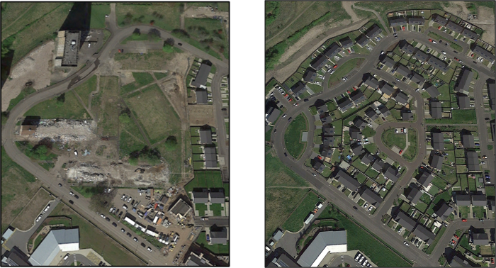How do changes in the built environment impact our health?
Published: 29 June 2023
Laura Macdonald discusses a novel method to explore how built environment change across Scotland might be associated with population health.
By Laura Macdonald, Research Associate with the Places and health programme.
The built environment encompasses human-made physical features in which people live, work and interact. This includes buildings, roads and created and managed green spaces such as urban parks. Our neighbourhood built environments change and evolve often; some changes are minor, while others involve major transformation. Change can take various forms; green space created, or removed, existing housing or amenities demolished, new housing estates built, new motorways created, or existing transport infrastructure modified or extended. Figure one shows changing built environment over time in one Glasgow neighbourhood.

Figure 1 - Built environment change, 2015-19, in a Glasgow neighbourhood (Map data Google Earth, 2023)
Public health research increasingly acknowledges that characteristics of the built environment can influence health in positive or negative ways. For example, access to neighbourhood green space has been consistently associated with numerous physical and mental health benefits, while conversely, higher road densities near housing have been associated with health risks, predominantly due to poorer air quality. Less is known about if/how built environment change affects health. If we understand more about how the built environment influences, and potentially improves, health then we can use policy and planning to direct change to the populations and areas most in need.
Combining change measures with data on mortality
In our recently published paper in the Journal of Epidemiology and Community Health (JECH), we developed a novel method to explore how built environment change across Scotland might be associated with population health. We measured health using mortality rates. We used Ordnance Survey Open Map Local data within Geographic Information System (GIS) software to quantify change in building and road infrastructure, and in woodland, between 2015 and 2019. We combined the change measures with data on mortality to explore associations between change and deaths from all causes and specific causes (e.g., from respiratory disease). We also explored change ‘context’ and whether areas targeted for change already had lower or higher mortality levels at baseline (i.e., 2015), and whether these areas were more or less deprived.
What did we find?
We found that around 60% of small areas, i.e., data zones, experienced built environment change over time, and this varied by income deprivation. Within more deprived areas, a greater percentage showed no built environment change over time (39%), compared to less deprived areas (28%). Around 19% of less deprived areas gained woodland and infrastructure, in comparison to around 8% of poorer areas. We didn’t find an association between change in the built environment and change in mortality but did find that areas that went onto gain infrastructure had lower death rates to begin with.
Why does this matter?
We did not find an association between built environment change and mortality in our study, this may reflect that the period of time for change was not long enough to translate to meaningful impact. Interestingly, we did find that more areas exhibiting change were less deprived (and also urban). This may reflect the locations where investment is higher, where land is more available and where opportunities for commerce are greater. Scottish cities continue to redevelop land in and around city centres, with policy supporting densification and brown field site (re)development. The location of these developments is intended to benefit sustainability, commerce, and tourism.
Our finding that areas that were going to gain infrastructure already had lower death rates perhaps signifies the targeting of more vibrant, already advantaged areas for (re)development. This is concerning as in Scotland those in poorer areas are more likely to suffer exposure to an environment that negatively impacts their health and to die prematurely. It is also a warning to other researchers who are trying to assess the impacts of changes in the built environment on health. Studies which do not take into account that healthier places may be more likely to experience built environment changes in the first place might end up drawing the wrong conclusions about their impact.
Further research is needed to explore where change might be directed to benefit the health of those in deprived areas. Such research is vital as investment concentrated in advantaged areas has the potential to widen health inequalities.
What’s next?
We recognise that built environment change was measured over a relatively short time, and we acknowledge that the cause of disease is often long-term, future research could use similar methodologies to quantify change over 10, 20, or more years. We continue to explore this area via the ‘Built Environment Context and Change Atlas’ (BECCA) project and to extend our work to the whole of Britain.
Disclaimer: The views expressed in this blog are those of the author.
First published: 29 June 2023

